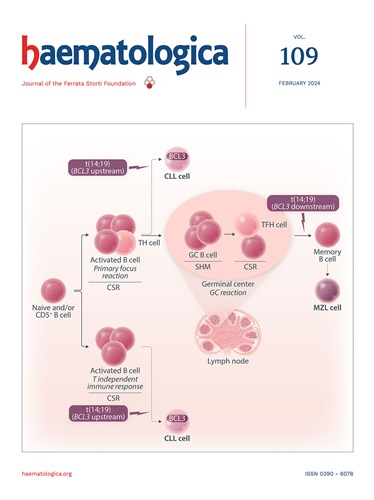Characterization, outcome and identification of prognostic factors for patients with systemic immunoglobulin light-chain amyloidosis requiring dialysis prior to initial anti-clonal therapy.
IF 7.9
1区 医学
Q1 HEMATOLOGY
引用次数: 0
Abstract
AL amyloidosis is a serious disease characterized by the deposition of immunoglobulin light chains in multiple organs. Renal involvement occurs in up to 70% of patients, but only a minority require dialysis before initiating anti-clonal treatment. Understanding the occurrence of end-stage organ damage is crucial to pave the way for reversing deposition. Currently, there is no detailed analysis available for this rare patient subgroup. We conducted a systematic search across three amyloidosis centers and characterized 68 biopsy-proven AL amyloidosis patients who required dialysis prior to initial anti-clonal therapy. In our cohort the second most affected organ was the heart. Renal parameters exhibited variability. Residual urine output and proteinuria ranged widely, while anuria had developed in only a few patients. Among the treated patients, 84% received Bortezomib as first-line therapy. The median overall survival (OS) was 44.8 months, with a median event-free survival (EFS) of 16.8 months. Our univariate statistical analysis revealed that underlying clonal disease, indicated by plasma cell infiltration, but not dFLC, impacted OS. Importantly, higher levels of troponins were associated with worse OS, confirmed by multivariate analysis, whereas NTproBNP levels and classical echocardiographic parameters such as septal thickness and longitudinal strain did not demonstrate significant prognostic value. This study provides crucial insights into this unique cohort of dialysis-dependent AL amyloidosis patients. The underlying clonal disease and markers of cardiac damage are important prognostic criteria. These findings emphasize the need to refine prognostic scoring systems for dialysis-dependent AL amyloidosis patients to better stratify risk and optimize treatment approaches.在初始抗克隆治疗前需要透析的全身性免疫球蛋白轻链淀粉样变性患者的特征、结局和预后因素的鉴定
AL淀粉样变性是一种以免疫球蛋白轻链沉积为多器官为特征的严重疾病。高达70%的患者肾脏受累,但只有少数患者在开始抗克隆治疗前需要透析。了解终末期器官损伤的发生是为逆转沉积铺平道路的关键。目前,还没有针对这一罕见患者亚组的详细分析。我们在三个淀粉样变中心进行了系统的搜索,并对68例活检证实的AL淀粉样变患者进行了特征分析,这些患者在初始抗克隆治疗之前需要透析。在我们的队列中,第二大受影响的器官是心脏。肾脏参数表现出变异性。残尿量和蛋白尿范围广泛,而无尿仅在少数患者中发生。在接受治疗的患者中,84%接受硼替佐米作为一线治疗。中位总生存期(OS)为44.8个月,无事件生存期(EFS)为16.8个月。我们的单变量统计分析显示,潜在的克隆性疾病(由浆细胞浸润显示)影响OS,而非dFLC。重要的是,通过多变量分析证实,较高水平的肌钙蛋白与较差的OS相关,而NTproBNP水平和经典超声心动图参数(如间隔厚度和纵向应变)没有显示出显著的预后价值。这项研究为透析依赖性AL淀粉样变患者的独特队列提供了重要的见解。潜在的克隆性疾病和心脏损伤标志物是重要的预后标准。这些发现强调需要完善透析依赖性AL淀粉样变患者的预后评分系统,以更好地分层风险和优化治疗方法。
本文章由计算机程序翻译,如有差异,请以英文原文为准。
求助全文
约1分钟内获得全文
求助全文
来源期刊

Haematologica
医学-血液学
CiteScore
14.10
自引率
2.00%
发文量
349
审稿时长
3-6 weeks
期刊介绍:
Haematologica is a journal that publishes articles within the broad field of hematology. It reports on novel findings in basic, clinical, and translational research.
Scope:
The scope of the journal includes reporting novel research results that:
Have a significant impact on understanding normal hematology or the development of hematological diseases.
Are likely to bring important changes to the diagnosis or treatment of hematological diseases.
 求助内容:
求助内容: 应助结果提醒方式:
应助结果提醒方式:


